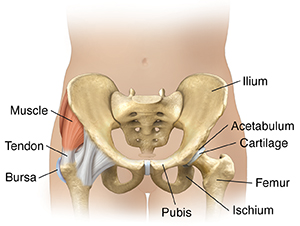A
B
C
D
E
F
G
H
I
J
K
L
M
N
O
P
Q
R
S
T
U
V
W
X
Y
Z
Topic IndexLibrary Index
Click a letter to see a list of conditions beginning with that letter.
Click 'Topic Index' to return to the index for the current topic.
Click 'Library Index' to return to the listing of all topics.
Hip Problems
What is the hip?
The hip is the area on each side of the pelvis. The pelvis bone is made up of 3 sections:
-
Ilium. The broad, flaring portion of the pelvis.
-
Pubis. The lower, rear part of the pelvis.
-
Ischium. One of the bones that helps form the hip.
The hip joint is a ball-and-socket joint that allows motion and gives stability needed to bear body weight.
The socket area (acetabulum) is inside the pelvis. The ball part of this joint is the top of the thighbone (femur). It joins with the acetabulum to form the hip joint.
The hip is one of the most stable joints in the body. But because it bears your body weight, it's more likely to develop arthritis because of the extra pressure. Pain in the hip may be caused by injury to muscles, tendons, or the small fluid-filled sacs (bursae) that cushion and lubricate joints.

What are common hip problems?
The following are some of the most common hip problems:
Arthritis
Arthritis is the most common cause of the breakdown of hip tissue. Three kinds of arthritis commonly affect the hip:
-
Osteoarthritis. This is also referred to as "wear and tear" arthritis. This type of arthritis damages the cartilage that cushions the bones of the hip wearing away. This lets the bones then rub together, causing hip pain and stiffness.
-
Rheumatoid arthritis. This disease causes the lining of the joint (synovial membrane) to become irritated and make too much fluid. It damages the cartilage, leading to pain and stiffness.
-
Traumatic arthritis. This is often the result of an injury or fracture.
Bursitis
In this condition, the fluid-filled sac (bursa) in the joint becomes inflamed. The bursa functions as a gliding surface to reduce friction between tissues. There are 2 major bursae of the hip. Both can cause stiffness and pain around the hip joint:
Other common hip problems:
-
Avascular necrosis. This condition involves death of bone tissue from a lack of blood supply. The blood supply to the bone can drop off for many reasons. Corticosteroid medicines can cause avascular necrosis in some people. It can also be caused by injury or bone tumors. It may lead to breakdown and collapse of the hip joint.
-
Hip pointer. A bruise or tear in the muscle that connects to the top of the ilium. The ilium is the crest of the pelvis, just below the waist. Causes of a hip pointer may include a blow, a fall, or a quick twist or turn of the body.
Online Medical Reviewer:
Dan Brennan MD
Online Medical Reviewer:
Diane Horowitz MD
Online Medical Reviewer:
Raymond Kent Turley BSN MSN RN
Date Last Reviewed:
4/1/2023
© 2000-2024 The StayWell Company, LLC. All rights reserved. This information is not intended as a substitute for professional medical care. Always follow your healthcare professional's instructions.